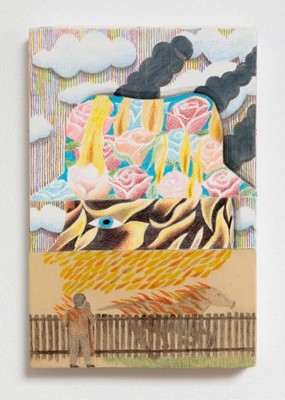Timothy Wehrle
Love Tones and Head Stones
Stellarhighway, Brooklyn
March 29 - May 25, 2025
End of an Era, 2023
Colored pencil on fabric and paper,
mounted to wood panel, 9 x 6 inches
© Timothy Wehrle, courtesy Stellarhighway
Ödland Sexwuste, 2024
Colored pencil, homemade ink, acrylic, dime
and dried flowers on paper,
mounted to wood panel, 30 x 24 inches
© Timothy Wehrle, courtesy Stellarhighway
Magic Personality, 2025
Colored pencil, homemade ink and acrylic
on paper with found object, wax and human nails,
mounted to wood panel, 30 x 24 inches
© Timothy Wehrle, courtesy Stellarhighway
TIMOTHY WEHRLE is back with a set of five exquisitely rendered large-scale works on paper that continue his exploration of the psyche. In addition to his signature meticulous line drawings and hallucinogenic pattern-on-pattern layering, the works share certain iconographic elements. As the title of this exhibition suggests, Love Tones and Head Stones, Wehrle is mapping the thorny terrain of emotions with their precipitous highs and lows. Executed between 2024-25 these works reflect inner reckonings with isolation, interpersonal relationships, and political upheaval. A persistent character is a face in profile, shown from the nose up, a distant relative of the smooth-pated Phrenology bust whose head is divided into pseudo-scientific sections like “benevolence, self-esteem, combativeness…” Wehrle replaces words with imagery.At the bottom of Some Still Say He’s a Good Person/a, such a head anchors the composition, a dizzying and phantasmagoric landscape of disparate parts blended by the artist to represent the vagaries of life. In the lower right corner, a faceless man in a suit (perhaps the ghost of Michael Jackson) operates the lever of a giant rollercoaster. As we follow its ascent it moves past a minimalist screen of embossed dots on white paper, only to dramatically loop around and drop, crashing head on into the center of the face’s forehead—occupied by a rendition of Disney’s Magic Castle—that explodes like a supernova, radiating stars, planets and a string of binocular-yielding heads that call to mind the black-masked faces embedded in Adolf Wolfli’s manic compositions.Stairway to Seven consists of five paper panels vertically mounted and connected by a multitude of figures ascending a zig-zag escalator. They move through a landscape made up of half-heads, now containing rows of numbers that insinuate the passage of time. These rainbow-colored numerals are echoed on the left by inset rows of dice, propounding the journey of life ruled by chance. At number 7, Seventh Heaven, clouds part to reveal another Michael Jackson, the new Saint Peter at the Pearly Gates, this time dancing. Ödland Sexwuste, an amalgam of recycled and collaged etchings and drawings onto a larger-sized paper, employs colorful repetitive elements of faces, patterns, and starbursts in a diagrammatic manner reminiscent of archaic esoteric illustrations. Filling the right side of the composition is a ladder with climbing nude figures who carry large severed ears on their backs like wings, nightmarish cupids somehow moving upwards and onwards.Wehrle’s most recent work, Magic Personality, is a witchy incantation, replete with candles, crows and an Yggdrasil-like tree whose roots enter dark subterranean realms. Simultaneously whimsical, bitter and spiritually transcendent, the details in this work merit closer examination. The lower half reveals that an emotional exorcism is at work: mouths whisper into ears; the candles are in different colors like those used in magic; and, a row of magicians holding moon-like mirrors appear to trap entities within them. Enclosed by yellow and purple drops / flames, alchemical transformations are taking place above, while a reclining nude points her binoculars upwards towards a multicolored orbed spiral, hinting at better things to come. Within the embedded children’s toy at the top center, a familiar game whereby metal shavings are moved to form a face and beard, we see the half-head again, the artist’s doppelganger.This is a rich and complex body of work, so be prepared to spend a long time looking at the details, then stepping back, and looking again. It is the kind of imagery that reveals itself over time and through attention, at once intensely personal and also universal. Like the drawings in Carl Jung’s visionary Red Book, Thimothy Wehrle attempts to express the abstract psychological concepts of emotional evolution, healing, and psychic transmutation in an accessible visual language that all can, on some level, understand.Text by Susan L. Aberth, Edith C. Blum Professor of Art History & Visual Culture at Bard College.
TIMOTHY WEHRLE (b. 1978; US) makes obsessive artwork that is a patchwork of scenes both real and imagined. In them, the artist’s emotional labor unfolds: an ongoing quest for a sense of self and belonging. Exploring the dynamics and pitfalls of contemporary culture, Wehrle’s imagery deftly fuses an aura of charm with a complex vision of humanity, posing questions about civilized existence. Executed in graphite, colored pencil and ink that he makes himself from walnuts, Wehrle’s intricate images distill moments of experience like pages from a diary. His conceptual material is wide-ranging, spanning topics of lighthearted homage ( a quirky dog he saw on the street or the festive tendencies of octogenarians), to the poetry of everyday life (the mind-expanding capabilities of music, the intangibility of beauty and the complexities of love), to harsh comments on the ills of society (child abuse, poverty, internet pornography, the divisiveness of technology and the ultimate breakdown of human interaction). Timothy Wehrle held a solo exhibition at the John Michael Kohler Art Center in Sheboygan, WI and has worked with galleries and institutions including Cavin Morris, New York, NY; Shrine, New York, NY; PPOW, New York, NY; and, Dieu Donne, New York, NY.
STELLARHIGHWAY
Brooklyn, NY 11233



